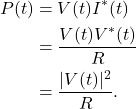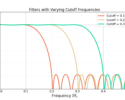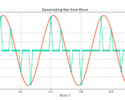Table of Contents
Introduction
What does it mean for a discrete-time signal to have energy or power? This blog reviews energy and power in electrical circuits and then transforms the concepts into the discrete-time and digital domain.
More DSP blogs:
Electrical Circuits
Before discussing the energy and power of of a discrete-time signal, let us review the concepts in the domain of electrical circuits.
The instantaneous power at time t is represented by P(t). In an electrical circuit the power is defined as the product of the current I(t) and the voltage V(t),
(1) ![]()
For a resistor the voltage is related to the current through the amount of resistance R using Ohm’s law,
(2) ![]()
such that the power in (1) is therefore
(3) 
The energy E in an electrical circuit is the cumulative power over time, represented by the integral
(4) 
Challenges in Translating into Discrete-Time Signals
What does it mean for an discrete-time signal to have energy and power? Discrete-time signals are represented by arrays of numbers on a computer. How can they have energy and power? The key is to understand that the numbers themselves cannot have power, it’s the physical quantity that they represent which has power.
Before moving on, it’s important to note that calculating the real-world power or energy from a discrete-time signal can be done with the proper calibration of a system. However, that calibration is outside the scope of this blog. Rather, the goal is to describe the first step in that direction, and that how to compute the power and energy within a discrete-time signal such that calibration could be performed later.
The concepts of power (3) and energy (4) have two hurdles that need to be overcome when translating them into discrete-time signals:
- Changing from continuous time into discrete time
- The resistance R
Power and Energy in Discrete-Time Signals
The instantaneous power P(t) can be transformed into discrete-time by sampling the voltage periodically at time
(5) ![]()
such that the discrete-time voltage is
(6) ![]()
The instantaneous power from (3) can therefore be written as
(7) ![]()
Discrete-time signals have been sampled and therefore removed from any type of resistive load. A simplifying assumption is made, R=1, such that the term can be removed. The final representation for instantaneous power is therefore
(8) ![]()
The average power is a time-average of (8). A time-average of N samples of the instantaneous power would be defined by [Lyons2011, p.874]
(9) ![Rendered by QuickLaTeX.com \begin{equation*}\begin{split}P_{avg} & = \frac{1}{N} \sum_{n=0}^{N-1} P[n] \\& = \frac{1}{N} \sum_{n=0}^{N-1} |V[n]|^2.\end{split}\end{equation*}](https://www.wavewalkerdsp.com/wp-content/ql-cache/quicklatex.com-83a9a47daab5757eea4373708897129a_l3.png)
An analog to digital converter converts voltage into digitized bits and that transformation can be represented by a change in variable from V[n] into the more common x[n],
(10) ![]()
as found in [oppenheim1999, p.60]. The energy (4) is the cumulative power over all time, which is represented by a summation
(11) ![Rendered by QuickLaTeX.com \begin{equation*}\begin{split}E & = \sum_{n=-\infty}^{\infty} P[n] \\& = \sum_{n=-\infty}^{\infty} |x[n]|^2.\end{split}\end{equation*}](https://www.wavewalkerdsp.com/wp-content/ql-cache/quicklatex.com-770a9a4e039074ebd481c2a289bece9b_l3.png)
Conclusion
This blog described how power and energy are calculated for an electrical circuit and then translated those concepts into the discrete-time domain. Discrete-time equations for power and energy were given.
More DSP blogs:
![Figure 1: The two sequences for the autocorrelation of x0[n] and x0[n].](https://www.wavewalkerdsp.com/wp-content/uploads/wordpress-popular-posts/5515-featured-125x100.png)







